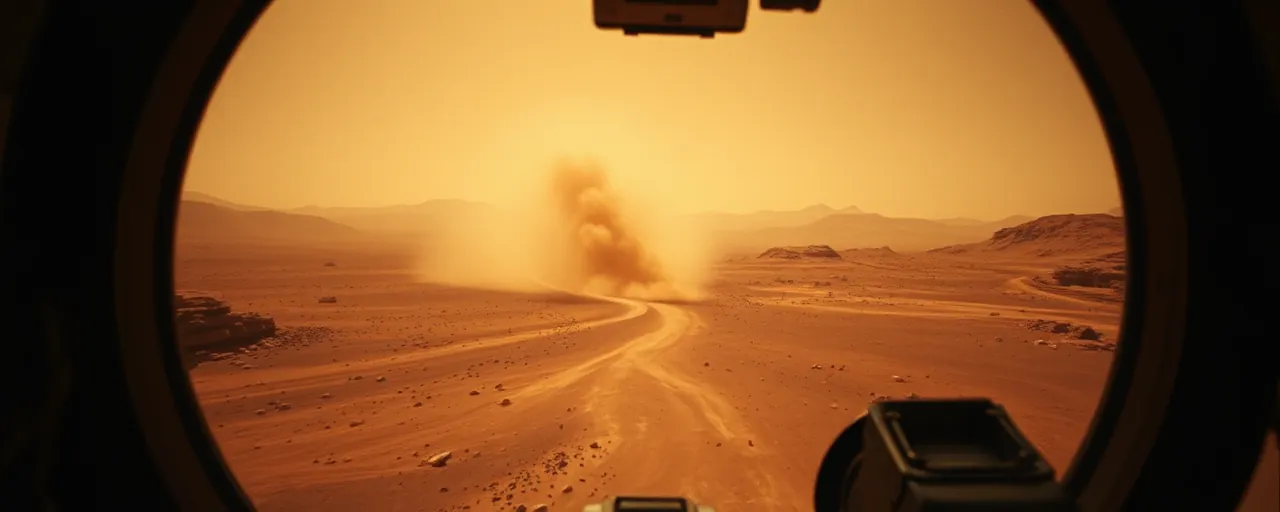A Dusty Dance in Jezero Crater
A striking video from NASA’s Perseverance rover has revealed a dramatic moment on Mars: a towering dust devil swallowing a smaller one in a swirling clash of wind and grit. Captured on January 25, 2025, along the rim of Jezero Crater, the footage offers a front-row seat to the Red Planet’s restless atmosphere. These mini-twisters, common across Mars’ arid landscape, churn up dust and carve fleeting patterns on its surface, hinting at the dynamic forces shaping this alien world.
The rover, parked about 0.6 miles from the action at a spot dubbed Witch Hazel Hill, used its navigation camera to record the encounter. The larger dust devil stretched 210 feet wide, dwarfing its 16-foot-wide companion. Two other whirlwinds loomed in the background, adding to the scene’s chaotic energy. For scientists, this isn’t just a spectacle; it’s a chance to decode the Martian weather patterns that drive these vortices and influence the planet’s climate.
The Science Behind the Spin
Dust devils form when warm air near the Martian surface rises through cooler layers above, spinning as it goes. This process picks up speed, much like a figure skater pulling in their arms, and scoops up loose dust to create the visible columns that roam the planet. On Mars, where the atmosphere is thin, these whirlwinds can grow hundreds of feet tall yet pose little danger. They’re a key player in moving about half the dust that hangs in the Martian air, affecting everything from visibility to temperature.
Researchers like Mark Lemmon from the Space Science Institute see these events as more than curiosities. He describes dust devils as unpredictable wanderers that can either merge or destroy each other when their paths cross. The Perseverance team seized this moment to study the forces at play, building on decades of observations that stretch back to NASA’s Viking missions in the 1970s, which first photographed these dusty spirals from orbit.
A Legacy of Watching the Winds
NASA’s rovers and orbiters have tracked Martian dust devils for nearly 50 years, piecing together their role in the planet’s environment. The Viking 1 orbiter caught one casting a shadow in 1978, clocking its speed at 59 feet per second. Later, the Pathfinder mission snapped surface-level shots in the 1990s, while the Spirit and Opportunity rovers documented their own whirlwind sightings. Perseverance even recorded the eerie hum of a dust devil in 2021 with its SuperCam microphone, a first for Mars exploration.
Across the planet, the Curiosity rover, working in Gale Crater, spots them too, underscoring how widespread these phenomena are. Katie Stack Morgan, a Perseverance project scientist at NASA’s Jet Propulsion Laboratory, points out their importance. She notes that dust devils reveal wind directions and speeds, offering clues about atmospheric conditions that could one day guide human explorers. Their study also ties into broader efforts to model Mars’ weather, where seasonal dust storms and unique energy flows shape a climate unlike Earth’s.
Beyond the Dust: Perseverance’s Bigger Mission
While dust devils steal the spotlight, Perseverance’s work digs deeper. Since landing in Jezero Crater in 2021, the rover has been hunting for signs of ancient microbial life, collecting rock samples that might hold biosignatures from a time when Mars ran with water. These samples, part of the Mars Sample Return Program with the European Space Agency, could reach Earth by 2040 for detailed analysis, though rising costs and technical hurdles keep the timeline in flux.
The rover’s findings also feed into NASA’s long game: preparing for human footsteps on Mars. By mapping the planet’s geology and past climate, Perseverance is laying groundwork for the agency’s Moon to Mars push, which includes Artemis missions to test tech closer to home. Dust devils, in their own way, fit into this puzzle, showing how the Martian environment behaves day to day, a practical concern for anyone planning to live there.
What the Whirlwinds Tell Us
The latest video isn’t just a one-off. It builds on a growing pile of data that helps scientists understand Mars’ atmosphere, from its thin carbon dioxide veil to the dust that colors its skies. Dust devils don’t just shuffle surface material; they hint at how wind and heat interact in a place where the air pressure is a fraction of Earth’s. That knowledge matters for predicting bigger events, like the global dust storms that can blanket Mars and scramble mission plans.
For those watching from Earth, the sight of a dust devil gobbling up its smaller kin feels oddly alive, a reminder that Mars isn’t a dead rock. It’s a planet with weather, history, and secrets still locked in its soil. As Perseverance keeps rolling, each image and sound it captures pulls us closer to grasping what makes the Red Planet tick.
